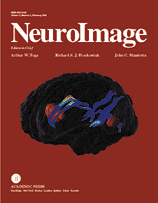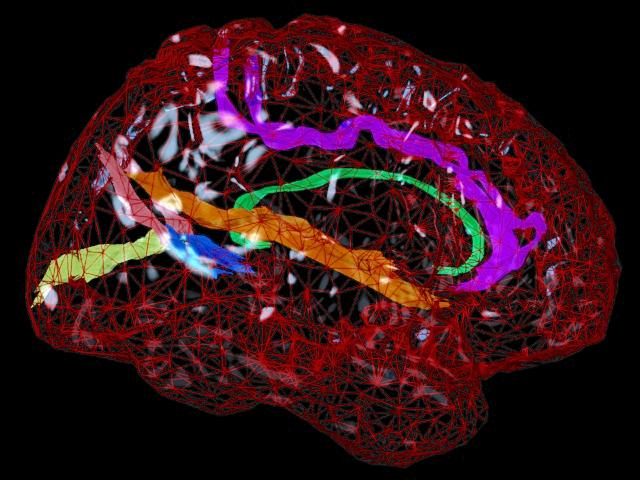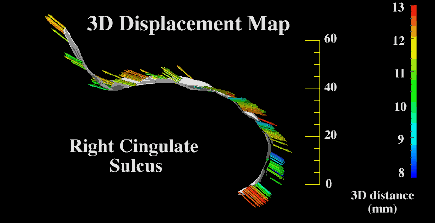 NeuroImage:
Volume 3, Number 1; February 1996
NeuroImage:
Volume 3, Number 1; February 1996


Paul M. Thompson, Craig Schwartz and Arthur W. Toga
Laboratory of Neuro Imaging, Department of Neurology, Division of Brain Mapping, UCLA School of Medicine, Los Angeles, California 90095
 NeuroImage:
Volume 3, Number 1; February 1996
NeuroImage:
Volume 3, Number 1; February 1996

Scheme for Matching Connected Systems of Anatomic Surfaces. Accurate detection and encoding of anatomic differences between subjects requires transformation tools that deform connected systems of mesh-based surface models representing structures in one subject's anatomy, into correspondence with their counterparts in the anatomy of another subject. The computation of this mapping is conceptualized mathematically as a surface-based displacement map, which deforms each surface locally into the shape of its counterpart. Maintenance of information on surface connectivity guarantees accurate mapping of curved junctions among surfaces, under both the surface-based and subsequent volumetric transformations. Note: Matching of surfaces with a spherical parameterization requires the design of separate methods, which deal with the matching of curved internal landmarks.
Striking variations exist, across individuals, in the internal and external geometry of the brain. Such normal variations in the size, orientation, topology and geometric complexity of cortical and sub-cortical structures have complicated the problem of quantifying deviations from normal anatomy, and of developing standardized neuroanatomical atlases.
This paper describes the design, implementation and results of a technique for creating a 3-dimensional probabilistic surface atlas of the human brain. We have developed, implemented and tested a new 3D statistical method for assessing structural variations in a database of anatomic images. The algorithm enables the internal surface anatomy of new subjects to be analyzed at an extremely local level. The goal was to quantify subtle and distributed patterns of deviation from normal anatomy, by automatically generating detailed probability maps of the anatomy of new subjects.
Connected systems of parametric meshes were used to model the internal course of the following structures in both hemispheres: the parieto-occipital sulcus, the anterior and posterior rami of the calcarine sulcus, the cingulate and marginal sulci, and the supracallosal sulcus. These sulci penetrate sufficiently deeply into the brain to introduce an obvious topological decomposition of its volume architecture. A family of surface maps was constructed, encoding statistical properties of local anatomical variation within individual sulci. A probability space of random transformations, based on the theory of Gaussian random fields, was developed to reflect the observed variability in stereotaxic space of the connected system of anatomic surfaces. A complete system of probability density functions was computed, yielding confidence limits on surface variation.
The ultimate goal of brain mapping is to provide a framework for integrating functional and anatomical data across many subjects and modalities. This task requires precise quantitative knowledge of the variations in geometry and location of intracerebral structures and critical functional interfaces. The surface mapping and probabilistic techniques presented here provide a basis for the generation of anatomical templates and expert diagnostic systems which retain quantitative information on inter-subject variations in brain architecture.
Key words: brain mapping, probabilistic atlas, sulcal anatomy, stereotaxic methods, digital image reconstruction
Paul Thompson
| RESUME| E-MAIL ME| PERSONAL HOMEPAGE| PROJECTS |
|---|